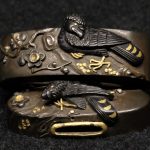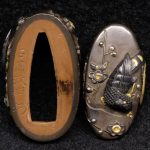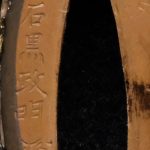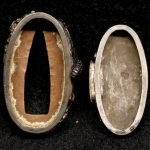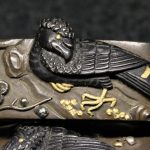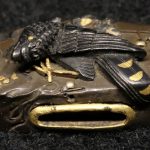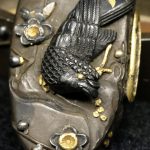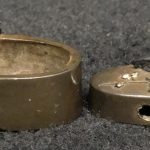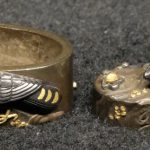FUCHI / KASHIRA ISHIGURo MASAAKI / HAWKS
FUCHI / KASHIRA / ISHIGURO MASAAKI / HAWKS
STUDENT OF ISHIGURO MASATSUNE
MEI: ISHIGURO MASAAKI + KAO
DATE: NONE c. MID 1800’S
DIMENSIONS:
FUCHI ID: 1.31” X 0.67”
KASHIRA ID: 1.25” X 0.52”
FUCHI OD: 1.48” X 0.88”
KASHIRA OD: 1.37” X 0.63”
ANA: 1.05” X 0.29”
DESCRIPTION:
Gorgeous, pristine Ishiguro Fuchi/Kashira depicting a theme of Hawks sitting in ume or sakura branches. Birds of course was where this school excelled. A somewhat usual design as most hawk designs depicts them on the wing. The base is shibuichi and the hawks are carved in high relief (takabori iroe) with gold highlights.
FROM SESKO’S, TOSO KINKO SCHOOLS
Ishiguro Masatsune (石黒政常), 1st gen. Masatsune – his first name was „Zenzō“ (善蔵) followed by
„Shūsuke“ (周助) – was the founder of the Edo Ishiguro school. He was born in the tenth year of Hōreki (1760) and studied initially under Katō Naotsune (加藤直常, see chapter 16.6). Before that he was also taught for a certain time by Naotsune´s master Yanagawa Naomasa. When he became independent he took a character from each of his masters, namely „tsune“ (常) from „Naotsune“ and „masa“ (政) from „Naomasa“ and combined them to „Masatsune“. With his extraordinaly skill he was able to give the Ishiguro school a strong position in the system of the Yokoya lineages. His harmonic balance between motif and shape of the piece was highly appreciated, as was his perfect nanako.
*The strong point of the Ishiguro school were interpretations of birds combined with floral motifs, the so-called subject of „kachō“ (花鳥), whereas most works were done in shakudō with nanako ground and a takabori-iroe ornamentation.
Ishiguro Masaaki (政明) – his first name was „Sadakichi“ (定吉) – was born in the tenth year of Bunka (1813). He was a student of the 1st gen. Masatsune and used as gō the name „Moku´ensai“ (木鳶斎). His year of death is unknown, but the latest known dated signature is the fourth year of Kaei (1851).
*The strong point of the Ishiguro school were interpretations of birds combined with floral motifs, the so-called subject of „kachō“ (花鳥), whereas most works were done in shakudō with nanako ground and a takabori-iroe ornamentation.
References:
KINKO MEIKAN: page 433
TOSO KINKO SCHOOLS, by Markus Sesko, 2012
SIGNATURES OF JAPANESE SWORD FITTINGS ARTISTS, by Markus Sesko, 2014
BAUR: page 229
HAYNES: H 0315.0
$1200 plus S/H and any associated fees (PayPal, bank wire, etc.)
